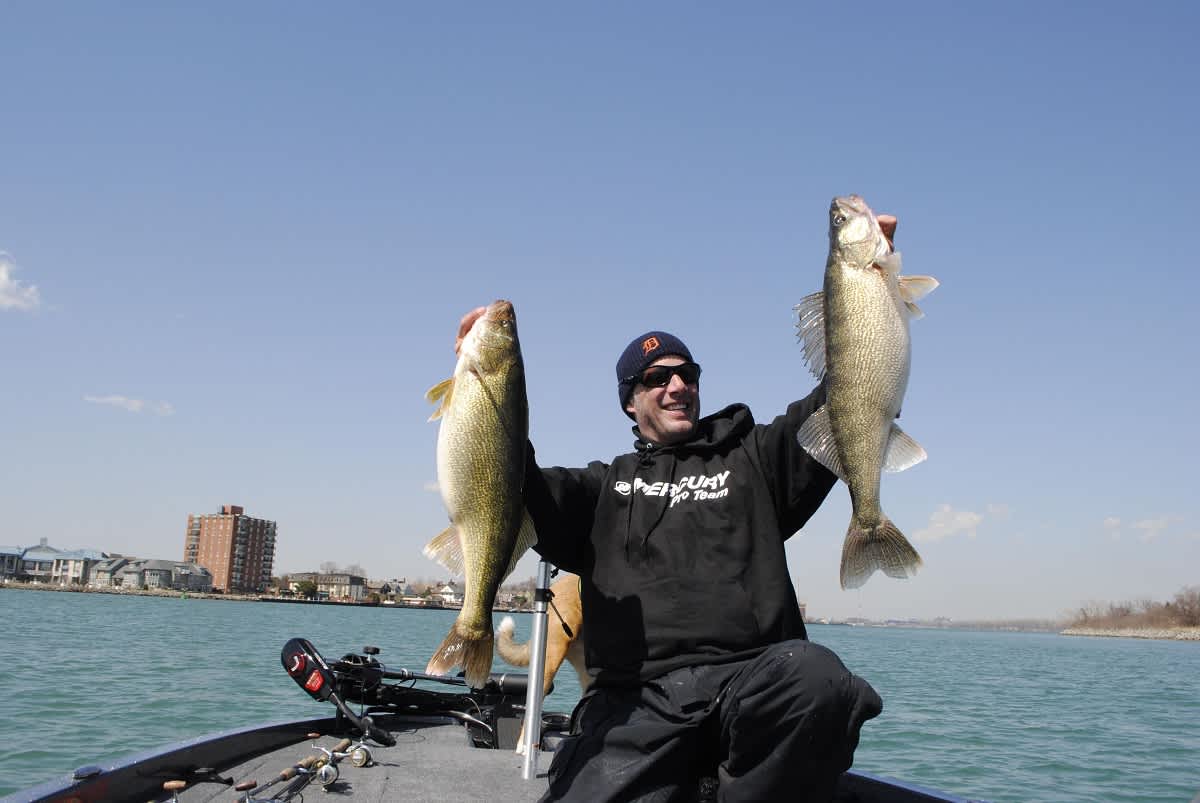Wonderful Detroit River Walleye
Bob Gwizdz 05.08.14

I felt just the slightest tick on the end of my line and when I set the hook, I thought, for a moment, that I’d hooked a log. But the line came alive and the next thing you know I was calling for a net. Gerry Gostenik responded and I slid a giant walleye into it.
“I’d say eight pounds, maybe more.”
“At least eight,” Gostenik responded.
I suggested we let her go, but Gostenik said I should but her in the livewell in case we caught another like her and we could make that photo of one in each hand. OK.
Thirty minutes later, Gostenik brought up a fish that was her twin, if not bigger. So we had our photo fish.
Twenty minutes later I caught a smaller one. This one would go about seven pounds. And a short while after that, I caught another that would weigh in the same vicinity.
“I think we’d win the tournament today,” Gostenik said.

Ah, the Detroit River. When it’s right, it’s the best fishing in the world—and this spring it has been most righteous.
Because I had expressed the opinion that I’d like to catch a couple to take home for dinner, Gostenik suggested we get out there and look for some smaller fish. That’s a good problem to have, no?
We were fishing mid -iver on a cold, late April day when you could practically walk across the river on the boats. The walleyes were on fire and apparently every angler in three states (and Ontario as well) had gotten the memo.
We were fishing with 5/8-ounce jigs tipped with short, straight-tailed plastic worms (black or brown, didn’t seem to matter). Minnows? “Don’t need them,” Gostenik said. “Waste of money.”
We covered an area where the water was 17 to 25 feet deep. All of our fish came from the shallower water.
“Those big sows are up on top of the bars,” Gostenik said.
We moved a couple of miles downstream. Gostenik hit a fish, almost immediately from about the same depth. This one was in the six-pound range.
I’ve run into this problem on the Detroit River before (being unable to catch the fish that I prefer, 18 inchers) because the big ones wouldn’t leave us alone. The big ones simply aren’t as good on the table as their younger sibs, and, besides, those big sows are more important in the water than out. They’re the future. The fisheries guys have been telling us for a couple of years that we’re approaching a hole in the age-class structure of the Lake Erie walleye population and from what I could see, there were more fish on the older side than the younger side.
Gostenik responded by snatching one in the four-pound class, a little bit bigger than what I wanted to take home, but good enough.

We were fishing with seven-foot medium heavy rods (bass rods) and spinning reels spooled with 10-pound Fireline and about two feet of fluorocarbon leader beneath a swivel. Gostenik had attached stinker hooks to the jig hooks, which he said was of paramount importance.
“You’ve got to use a stinger,” he said. “Some days, eight out of 10 will come on that stinger.”
Not his day. The big ‘un were getting every bit of the jig.
We drifted downstream and I set the hook on a 17-inch fish in 25 feet of water. Just what I wanted. The fish—which had been hooked on the stinger—fell off in the net. On the next drift, through, Gostenik caught one that was just shy of four pounds in deeper water.
I surmised that the males were out deeper while les femmes had staked out the tops of the bars. When we caught another table fish (around 20 inches) from 25 feet of water, again on the stinger hook, I sort of figured I was right.
By that time, I was totally satisfied with our day. We’d caught 10 walleyes—a number of them certifiable giants—in a little more than three hours of fishing. Does it get any better than that?
Gostenik said we could fish a little longer if I wanted, but I’d scratched my itch sufficiently. I had four to take home, and knowing that Gostenik has been putting in long days non-stop since the bite started in mid-April, I suggested he take the rest of the day off. He didn’t object very strenuously.
It’s been a fantastic spring on the Detroit River this year and, except for those few days when the wind gets up and the water gets muddy, the bite has been pretty consistent. Frankly, I like to fish the river even more in May—when the big ones have moved on and you typically catch those perfect, pan-sized walleyes—than in April or even March.
Gostenik, who has been running two five-hour trips a day this spring (“If you don’t catch them in five hours, you’re not going to catch them in eight,” he said) has very few openings until June, when he’ll start bass fishing. But if you’ve hankering to go, you can reach him at (313) 319-0100.
For more information on Michigan fishing go to michigan.org. Click here to purchase a Michigan fishing license online.
This article was produced in partnership with Pure Michigan.

